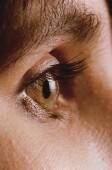Time Teaches Brain to Recognize Objects
Research could pave way for enhanced computer vision systems, MIT study suggests.
|
E-mail this article
Subscribe to news
Printer friendly version
|

(SOURCE: Massachusetts Institute of Technology, news release, Sept. 11, 2008)
THURSDAY, Sept. 11 (HealthDay News) -- Massachusetts Institute of Technology researchers say you really can't believe your eyes.
A team of neuroscientists publishing in the Sept. 12 issue of Science said they have tricked the brain into confusing one object the eyes see with another, proving that it takes time for humans to learn to recognize objects.
People never really see the same image twice, the team said. The retina receives innumerable impressions of the same image, depending on the direction of gaze, angle of view, distance and so forth. While neural activity changes as the eyes move, the perception of the image remains stable.
"This stability, which is called invariance, is fundamental to our ability to recognize objects but it is a central challenge for computational neuroscience," senior author James DiCarlo, of the McGovern Institute for Brain Research at MIT, said in a university news release. "We want to understand how our brains acquire invariance and how we might incorporate it into computer vision systems."
The authors believe the fact that our eyes often move rapidly (about three times per second), while physical objects usually change more slowly, results in "temporal contiguity," in which these differing patterns of activity in rapid succession reflect different images of the same object.
In the study, the team created an altered visual world for test monkeys. An object would appear in the monkeys' peripheral vision, but as their eyes moved to examine it, a different object would replace the original one. This change, which is not perceived by the monkeys, causes them to confuse the two objects. During this, the researchers recorded the activity of neurons in the monkey's inferior temporal (IT) cortex, a high-level visual brain area. IT neurons "prefer" certain objects and respond to them regardless of where they appear within the visual field.
"We first identified an object that an IT neuron preferred, such as a sailboat, and another, less preferred object, maybe a teacup," graduate student Nuo Li, who worked on the study, said in the same news release. "When we presented objects at different locations in the monkey's peripheral vision, they would naturally move their eyes there. One location was a swap location. If a sailboat appeared there, it suddenly became a teacup by the time the eyes moved there. But a sailboat appearing in other locations remained unchanged."
After a while, the monkeys' IT neurons became confused. The sailboat neuron still preferred sailboats at all locations, except at the place where the images were swapped. Here, it learned to prefer teacups. The longer the manipulation, the greater the confusion.
"We were surprised by the strength of this neuronal learning, especially after only one or two hours of exposure," DiCarlo said. "Even in adulthood, it seems that the object-recognition system is constantly being retrained by natural experience. Considering that a person makes about 100 million eye movements per year, this mechanism could be fundamental to how we recognize objects so easily."
The researchers are now testing this idea using computer vision systems viewing real-world videos.
More information
The U.S. National Library of Medicine has more about eyes and vision.
Copyright © 2008 ScoutNews, LLC. All rights reserved. 
HealthDayNews articles are derived from various sources and do not reflect federal policy. healthfinder.gov does not endorse opinions, products, or services that may appear in news stories. For more information on health topics in the news, visit the healthfinder.gov health library.